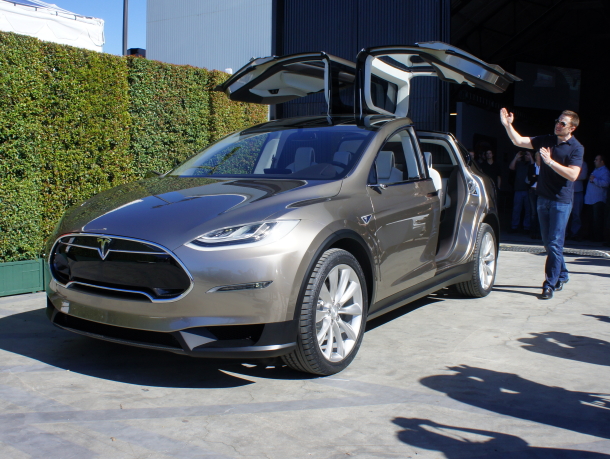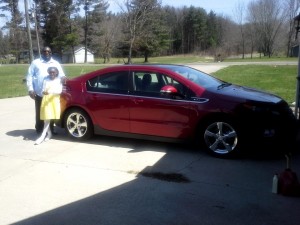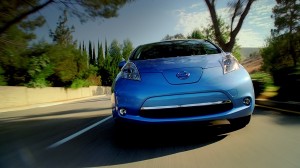 A lot of people are understandably wary about being early adopters of new technology. For the privilege, buyers often have to pay more and deal with unexpected problems. In the case of electric vehicles, the dynamic is the same, with many consumers worried about how long the batteries will last and what it will cost to replace them.
A lot of people are understandably wary about being early adopters of new technology. For the privilege, buyers often have to pay more and deal with unexpected problems. In the case of electric vehicles, the dynamic is the same, with many consumers worried about how long the batteries will last and what it will cost to replace them.
It’s hard to blame them. Reports from buyers of the first Nissan LEAF indicate that some batteries are failing pretty rapidly, sparking a class-action lawsuit. And some dealers of the Chevy Volt are quoting a whopping $34,000 for a full “drive motor battery replacement,” as Autoblog reports. Tesla, meanwhile, just unveiled a $29,000 replacement battery for their Roadster model, promising an additional 75 miles of range or so.
Autoblog performed a comprehensive look at what it might take to replace or repair a bad Chevy Volt battery, and the results are encouraging. For starters, after looking at the individual parts, the website found that while all three modules that make up the Volt battery add up to a fairly large $11,121.66 total, in most cases these battery cell modules do not need to be replaced:
There are many other individual pieces mounted on the battery pack that are serviceable, such as the Battery Energy Control Modules (BECM) and the Battery Interface Control Modules (BICM). These modules control and monitor the battery packs and charging system and have been known to fail while the lithium-ion battery cells are not at fault. Some have been replaced under warranty, but if you are stuck buying one they run about $255 a piece for the part. Getting a module replaced will cost you around $2,100 for parts, labor, and programming; labor can be a big hit since dropping the battery pack is required in order to service these modules.
If you are looking to replace the entire pack, the outlook has gotten better based on recent reports of refurbished battery packs becoming available for around $4,000. In these cases your entire battery pack is exchanged for one that comes from a refurbishing facility. These facilities do not produce any new parts but instead take packs that come in on exchange and combine the harvested pieces that are within spec from multiple packs to assemble refurbished packs.
Not bad prices if it buys you another 6-8 years of low-cost electric driving. The site includes a handy chart showing all the battery pack components:

Bottom line: fear of battery repair or replacement may not be such a big issue, particularly as we get more experience dealing with these used batteries coming out of the vehicles. Not to mention that there could and should be a robust market for buying these inexpensive used batteries, which would offer tremendous benefits for cleaning the grid and saving ratepayers money.
Electric vehicles as a clean technology movement have been in a holding pattern of late, if not a downright spiral. Sales are generally down from last year, battered by cheap gas prices and a lack of new models to excite consumers. Without advancements in the models, the broader consumer base is either unaware of EV benefits or cowed by perceived deficiencies (cost and range, mainly) of current EV options.
But that dynamic, I believe, is about to change.
New models are set to hit the roads this fall and winter that will likely start a new wave of EV buying. Most prominently, Tesla is finally talking to customers about designs for the new electric SUV, the Model X, set to release in limited production this month. The falcon-winged bad boy starts north of $130,000 though for the premium model, so sales will once again be aimed at the top 1% of us.
Chevy’s new Volt will also arrive this fall, complete with a marketing blitz. Early reviews sound positive, as the car looks better, drives longer on the battery (over 50 miles), and gets better gas mileage the few times you actually need it. Not to mention the new Nissan LEAF should be out soon, with possibly 120-mile range — a significant boost from the current 85-mile range.
When you add it up, the major EV automakers are set to introduce major upgrades to their products. While it’s harder to compete with cheap gas, EVs offer inherent benefits of a better and cleaner drive, lower maintenance costs, and the ability to drive for virtually free if you have solar PV on your roof. Plus, it’s the most important thing you can do for the environment if you have to drive.
So my guess is we’re in a holding pattern before some good news comes out on EV deployment. EVs won’t get to mass-market level for maybe another decade or so, but we’re getting there in big leaps, and this fall we should start to see another one take shape.
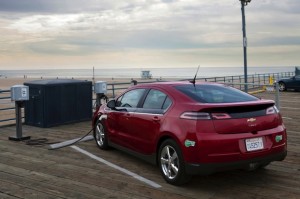 Among electric vehicle aficionados, the Chevy Volt is sort of a black sheep of the bunch. The car was one of the original “Big 3” of the electric vehicle market, along with the Nissan LEAF and Tesla Model S. But unlike those two cars, which represented opposite ends of the price and range spectrum for an all-battery vehicle, the Chevy Volt tried to be an all-in-one consumer car. For about $34,000 (without incentives), it features a 38-mile all-electric battery range. And then a gas engine kicks in to give you the full range of an internal combustion engine car.
Among electric vehicle aficionados, the Chevy Volt is sort of a black sheep of the bunch. The car was one of the original “Big 3” of the electric vehicle market, along with the Nissan LEAF and Tesla Model S. But unlike those two cars, which represented opposite ends of the price and range spectrum for an all-battery vehicle, the Chevy Volt tried to be an all-in-one consumer car. For about $34,000 (without incentives), it features a 38-mile all-electric battery range. And then a gas engine kicks in to give you the full range of an internal combustion engine car.
But the Volt has some obvious limitations. First is the 38-mile battery range. After that, the gas engine requires more expensive premium gas. And some customers complained about the lack of room in the back seat, with two adults fitting uncomfortably (whereas I can fit two carseats and a booster in the backseat of my LEAF). Perhaps as a result, sales have fallen in the last two years, as Inside EVs reports:
For full year 2014, 18,805cars were been sold – which is down 18.6% from 2013 when GM moved 20,702 Volts. This means that the Volt is the first electric vehicle to post two consecutive years of falling sales in America.
Some analysts believe the drop-off was in part due to customer awareness that Chevy was about to introduce a new version of the Volt this year. And that just happened:
The big news — other than the sleeker, all-new design — is that electric-only range has increased about a dozen miles to 50. At that point, a gas engine kicks in, offering a total range of “more than” 400 miles before a fill-up and recharge are necessary. The engine is all-new, a 1.5-liter unit that takes regular gas and delivers a combined fuel economy of 41 mpg when in use. Charging comes in 4.5 hours connected to a 240-volt source.
Yet if I had to guess, I think the Volt’s electric/gas combo presents a fundamental consumer challenge that will be hard to overcome. And it’s a problem for virtually any plug-in electric that also has a gas engine. In my view, with the electric/gas combo, you get the worst of both worlds without inspiring passion among any consumer group. The battery range isn’t enough to get drivers gas-free, a major shortcoming if you’re motivated by either environmental concerns or a desire for the superior driving experience of going electric. And the gas part of the car is expensive (premium fuel) and negates the low-maintenance advantage of an all-electric: you still need the extra thousand moving parts for an internal combustion engine, with all the sparkplugs and oil changes and transmissions to worry about.
I think most drivers want either all-electric or nothing. The extra range with a gas engine isn’t that necessary for most trips. An 85-mile range in a cheap all-battery car covers 95% of trips. You’re almost better off renting a cheap car for those few long-distance trips a year, rather than sticking a gas engine in your battery EV. The Volt is certainly a good car for those who only want one all-purpose car and really need the extra range from the gas engine — basically long-distance commuters. But I don’t think this plug-in/gas model is really viable in the long run, particularly as batteries improve in price and performance.
Perhaps that’s why Chevy is now working on the “Bolt” — an all-electric, $30,000, 200 mile range EV to compete with Tesla’s hyped up Model 3, due supposedly in 2017. It’s great to see the automakers competing for this coveted breakthrough in EV technology. And once the Bolt is out, I will definitely consider a Chevy EV. But not so much with the Volt.
And the honor goes to Erik Belmer of Ohio:
Erick Belmer is the proud owner of a 2012 Volt.
As Belmer tells InsideEVs, the Volt was purchased on March 28, 2012. Since then, it’s seen a daily commute of 220 miles there and back, with a single longest trip of 430 miles in a day.
Oil changes come every 38,000 miles and tire rotations every 10,000 miles. That’s basically all the maintenance that’s been required on Belmer’s Volt.
The particularly good news is that Belmer has seen no loss in battery capacity after all that driving:
“Volt is holding up flawlessly! No noticeable battery capacity loss. Used 9.7 kw because it’s a 2012. I am so pleased with this vehicle!”
“The Volt was always my dream car! To get to drive it everyday is a dream come true! This car is Wonderfully engineered!”
One important note is that the Chevy Volt has a gas engine that kicks in after about 40 miles of electric driving. So we won’t see this kind of mileage accrue in such a short period of time in an all-battery electric like the Nissan LEAF or BMW i3, which don’t have the range of the Volt on a daily basis.
But if all-battery EVs have their batteries hold up like Belmer’s, that bodes very well for the long-term value of the car. It would be reassuring to customers, many of whom are opting to lease the vehicles, in part out of doubts about long-term battery life. It also bodes well for the quality of second-life batteries, which can be reused outside of the vehicle for different energy storage options.
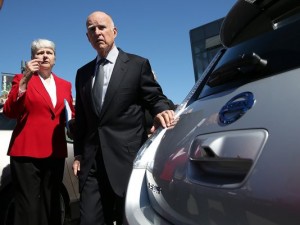 This past Friday in Sacramento, the Office of California Governor Jerry Brown convened a few hundred electric vehicle experts for an update on California’s progress deploying EVs. The attendees were mostly from California, including utility representatives, advocates, researchers, and officials. However, experts also came from places ranging from Oregon to the Netherlands. Some informational highlights from the conversation:
This past Friday in Sacramento, the Office of California Governor Jerry Brown convened a few hundred electric vehicle experts for an update on California’s progress deploying EVs. The attendees were mostly from California, including utility representatives, advocates, researchers, and officials. However, experts also came from places ranging from Oregon to the Netherlands. Some informational highlights from the conversation:
- The Netherlands recently reached a major milestone: 25% of their new car sales were electric vehicles. Part of the appeal: the Netherlands waived the sales tax on EVs and has invested heavily in charging stations. Maybe a good lesson for California as EV rebate money runs out? Waiving the sales tax on EVs, if it could pass the Legislature, would be a great incentive for purchase.
- Most Nissan LEAF, Chevy Volt, and Toyota Plug-In Prius customers were motivated by the environmental benefits and fuel savings. Tesla customers, however, were primarily motivated by vehicle performance and access to new technology. Survey results found here (collected by the entity that sends out vehicle rebates, which is a great source of market data like these).
- Most electric vehicle customers skew to the older, whiter, more highly educated, and male demographic.
- HOV (carpool) lane access was an “extremely or a very important purchase motivation” for 59% of EV customers. This bodes poorly for California as the state is running out of carpool lane stickers to distribute — like in a matter of months. The Governor’s Office vowed to make addressing this need a priority.
- California sales of EVs currently represent one-third of the national market, with 64,649 sold to date. The sales graph is definitely looking like a hockey stick, which is an incredible advance for the technology.
- An electric utility rep says that sales of California’s low carbon fuel credits could mean $200 a year back in the pockets of EV drivers. The low carbon fuel standard is part of California’s efforts to reduce greenhouse gas emissions to 1990 levels by 2020, and it requires fuel refiners to either limit the carbon content of their fuel or purchase credits on the open market. Since electric utilities are providing low-carbon fuel (electricity) to their EV customers, the utilities get to sell the credit to oil companies and then return the money to the EV drivers. And if the utility is saying $200 a year, it’s probably more like $500 a year, which is basically free charging at home for most EV drivers.
- Atlanta is the number 2 market in the US for Nissan LEAFs, due to HOV access and other state incentives in a congested urban area. San Francisco is #1 and Honolulu is #6 (and it could rise to the top in terms of percent of EVs sold each year). Even Nashville clocked in at #9. I like see red state cities showing up on this list. EVs should be a bipartisan priority.
Ultimately, the Friday convening was a success in terms of sharing the latest information, providing participants with a chance to influence state priorities on EVs, and giving people in the field a motivational boost. The state is doing incredibly well in terms of EV adoption, as the hockey stick sales graph and anecdotal observations can attest. Look for the key near-term priorities to be an extension of the HOV sticker program and making that low carbon fuel standard rebate happen quickly.
Full speed ahead, California EV drivers and those who will soon be one!

